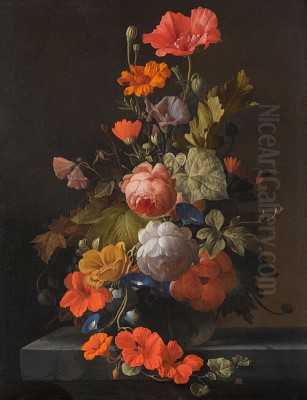
Elias van den Broeck (c. 1649/1657–1708) stands as a notable figure in the rich tapestry of Dutch Golden Age painting. Specializing in still life, particularly intricate depictions of flowers, insects, and forest floor scenes (known as 'sottobosco'), Van den Broeck carved a niche for himself with his meticulous detail, vibrant compositions, and occasionally unconventional techniques. His work reflects the era's profound fascination with the natural world, blending scientific observation with artistic virtuosity to create paintings that continue to captivate viewers with their delicate beauty and underlying symbolism.
Born in Antwerp, a major artistic hub, the precise year of Elias van den Broeck's birth is subject to some scholarly debate, with sources suggesting either 1649 or, more commonly, 1657. Regardless of the exact year, his formative artistic years were spent in a city teeming with talent. He later moved to Amsterdam, another vibrant center for the arts and commerce, further immersing himself in the flourishing Dutch art scene.
Apprenticeship and Early Influences
The most significant influence on Van den Broeck's early career was undoubtedly his tutelage under the celebrated still life painter Jan Davidsz. de Heem (1606–1684). De Heem was a towering figure in the genre, renowned for his lavish and complex still lifes, often featuring an abundance of flowers, fruits, and precious objects. Historical records indicate that in 1669, Van den Broeck entered into a formal apprenticeship contract with De Heem, committing to a two-year period of study. This training would have been intensive, focusing on the precise rendering of textures, the skillful handling of light and shadow, and the art of balanced composition – all hallmarks of De Heem's own work.
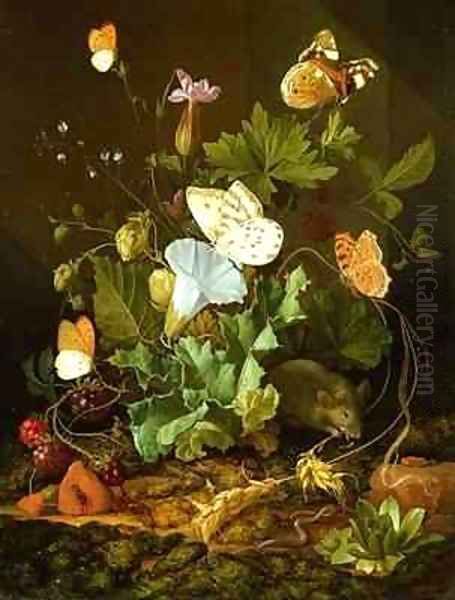
The impact of Jan Davidsz. de Heem on Van den Broeck's oeuvre is palpable. Many of Van den Broeck's floral arrangements echo the elder master's dynamic compositions and rich color palettes. De Heem himself had a workshop practice that involved assistants, and it's plausible that Van den Broeck contributed to works emerging from De Heem's studio, a common practice that allowed apprentices to hone their skills on specific elements within larger compositions. The artistic lineage is clear, with Van den Broeck absorbing the meticulous realism and opulent aesthetic characteristic of De Heem and his circle, which also included De Heem's son, Cornelis de Heem.
Artistic Style and Thematic Focus
Elias van den Broeck developed a distinctive style characterized by its exquisite detail and vibrant naturalism. His primary subjects were flowers, often arranged in vases or depicted growing in a more naturalistic forest floor setting. These floral pieces showcase a remarkable ability to capture the delicate textures of petals, the subtle gradations of color, and the interplay of light on leaves and stems. Roses, tulips, poppies, carnations, and other blooms are rendered with an almost botanical precision, yet they are imbued with an artistic vitality that transcends mere scientific illustration.
Beyond floral arrangements, Van den Broeck was particularly adept at the 'sottobosco' or forest floor still life. This subgenre, popularized by artists like Otto Marseus van Schrieck (c. 1619–1678), focused on the microcosm of life found in the undergrowth: fungi, mosses, thistles, small reptiles like lizards and snakes, and a variety of insects. Van den Broeck's forest floor scenes are teeming with life, often featuring a dramatic interplay of light and shadow that enhances their mysterious and untamed quality. These works reflect the 17th-century Dutch fascination with both the beauty and the potential dangers of the natural world.
Insects are a recurring motif in nearly all of Van den Broeck's paintings. Butterflies, beetles, caterpillars, snails, and ants are rendered with painstaking accuracy, often positioned on leaves or petals, adding a layer of intricate detail and symbolic meaning. In the context of Dutch still life, insects could carry various connotations, from symbols of transience and decay (flies, caterpillars) to resurrection and beauty (butterflies). Their inclusion enriched the narrative and intellectual depth of his compositions.
Compositional Strategies and Technical Skill
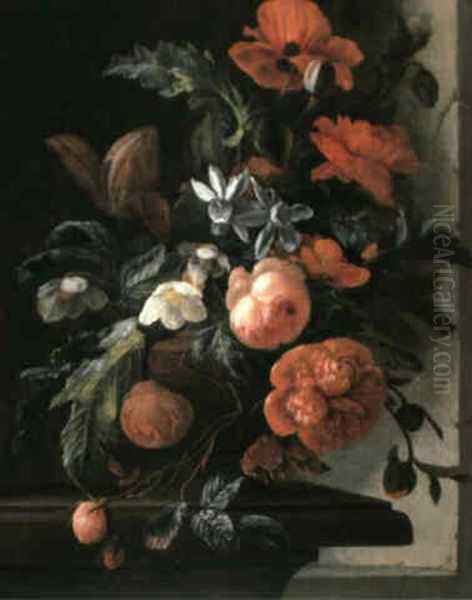
Van den Broeck's compositions are typically well-balanced, often employing diagonal arrangements to create a sense of dynamism and depth. In his floral pieces, flowers cascade from vases or are clustered in a way that feels both abundant and carefully orchestrated. The use of dark, often indistinct backgrounds, a common feature in Dutch still life, serves to highlight the vibrant colors and delicate forms of the flowers and insects, making them appear to emerge luminously from the shadows. This technique, known as chiaroscuro, was masterfully employed by many Dutch Golden Age painters, including Rembrandt van Rijn, though in different genres.
His brushwork is exceptionally fine and controlled, allowing for the precise rendering of minute details – the veins on a leaf, the powdery texture of a butterfly's wing, or the glistening dewdrop on a petal. This meticulous approach was highly valued by patrons of the time, who appreciated the artist's ability to create a convincing illusion of reality, a concept known as 'trompe-l'œil' (to deceive the eye). Artists like Willem Kalf (1619–1693), known for his opulent 'pronkstilleven' (showy still lifes), also excelled in rendering diverse textures with incredible fidelity.
The color palette in Van den Broeck's work is rich and varied, with a keen sensitivity to harmonious combinations and striking contrasts. He skillfully juxtaposed warm reds, yellows, and oranges with cool blues, purples, and greens, creating visually engaging and emotionally resonant scenes. The interplay of light is crucial, not only defining form but also imbuing his subjects with a sense of life and presence.
Notable Works and Their Characteristics
Several works by Elias van den Broeck are held in public and private collections, showcasing his distinct artistic signature. Among his representative pieces is "A Vase of Flowers on a Stone Slab," housed in the Ashmolean Museum, Oxford. This painting exemplifies his skill in floral arrangement, with a lush bouquet spilling from a glass vase. The flowers are rendered with characteristic detail, and the inclusion of various insects adds to the painting's complexity and naturalism. The cool stone slab provides a stable, contrasting base for the vibrant, ephemeral beauty of the blooms.
Another work, often titled "Flowers on a Forest Floor" (also in the Ashmolean Museum), demonstrates his mastery of the 'sottobosco' theme. Here, thistles, poppies, and other wildflowers are depicted growing amidst foliage, accompanied by butterflies, a snail, and perhaps a lizard or snake, creating a vivid snapshot of the woodland undergrowth. The composition feels less formal than a vase arrangement, capturing a more untamed aspect of nature.
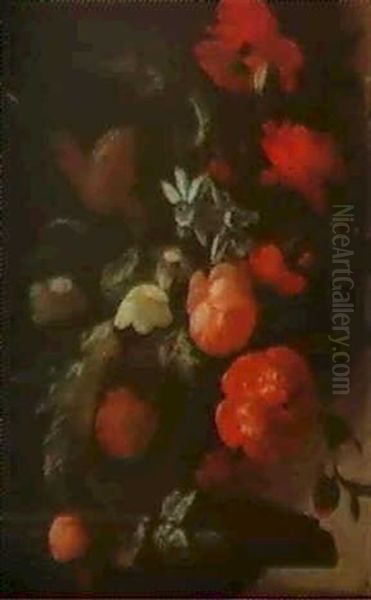
Paintings such as "Flowers and Butterflies" and "Flowers and Ruins," which have appeared at auction houses like Sotheby's, further illustrate his thematic concerns. The inclusion of ruins in some still lifes was a common 'vanitas' motif, reminding the viewer of the transience of earthly achievements and the passage of time, a theme also explored by still life painters like Pieter Claesz (1597–1660) and Willem Claeszoon Heda (1594–1680) in their "ontbijtjes" (breakfast pieces).
His "Still Life of Herrings" (c. 1675) indicates a broader range within the still life genre, though he is predominantly celebrated for his floral and forest scenes. This work would align more with the tradition of fish still lifes, a popular subject in the Netherlands, a nation with a strong maritime and fishing heritage.
The Butterfly Wing Controversy: An Unconventional Technique
One of the most intriguing and controversial aspects of Elias van den Broeck's artistic practice was his reported use of actual butterfly wings in his paintings. According to some accounts, he would press the wings of real butterflies onto the canvas, transferring their delicate, powdery scales to create an unparalleled level of realism for these specific elements. This technique, while innovative and perhaps initially impressive for its verisimilitude, apparently caused a stir.
It is said that this practice, described as "butterfly printing," angered some members of the artistic community or nobility in Antwerp. They purportedly viewed it as a shortcut or an affront to the traditional skills of painting, perhaps even a form of cheating that undermined the artist's craft of pure representation through pigment. The controversy was significant enough, according to these narratives, to lead to his expulsion from the city. While the full details and veracity of this expulsion are debated, the story highlights a tension between innovation and tradition, and the varying perceptions of what constituted legitimate artistic practice. If true, this technique would place him in a unique position, prefiguring certain aspects of collage or mixed-media art.
Later Career and Artistic Milieu
After his time in Antwerp and Amsterdam, Van den Broeck is documented as having returned to Amsterdam. By 1685, he had moved and settled near the Utrecht city gate (Utrechtse Poort) in Amsterdam, where he reportedly maintained a garden. This garden likely served as a direct source of inspiration and models for his floral and insect paintings, allowing him to study his subjects from life with great intimacy. Having live specimens readily available was a significant advantage for a still life painter dedicated to naturalistic representation.
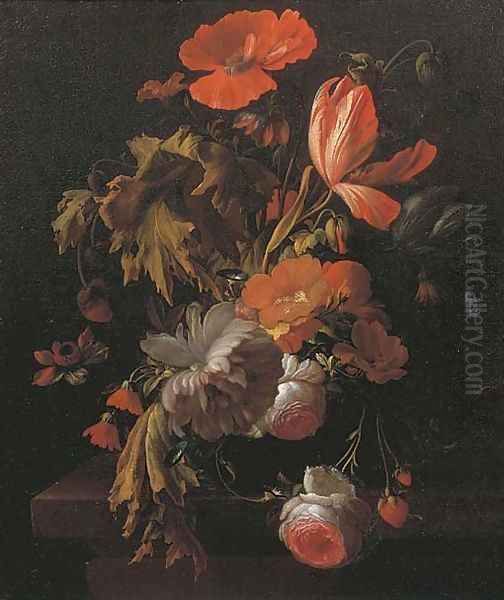
During his career, Van den Broeck was also associated with the Guild of Saint Luke, the professional organization for painters and other artists in many Dutch and Flemish cities. Membership in the guild was typically a prerequisite for practicing as an independent master, taking on apprentices, and selling works.
His artistic output places him firmly within the Dutch Golden Age, a period of extraordinary artistic production. He was a contemporary of other renowned still life painters such as Rachel Ruysch (1664–1750), a highly successful female artist celebrated for her dynamic and intricate flower paintings, and Abraham Mignon (1640–1679), another student of De Heem, known for his detailed floral and fruit pieces. While perhaps not achieving the same level of fame as Ruysch or the later Jan van Huysum (1682–1749), who brought flower painting to an almost rococo exuberance, Van den Broeck made a significant contribution to the genre. His work can also be compared to that of Maria van Oosterwijck (1630–1693), another prominent female still life specialist.
The broader artistic context of the Dutch Republic in the 17th century was characterized by a burgeoning middle-class art market. Patrons, often wealthy merchants and burghers, favored subjects that reflected their world and values: portraits, landscapes, genre scenes, and still lifes. Still life paintings, with their celebration of natural beauty, allusions to wealth (in the case of 'pronkstilleven'), and often subtle moral or religious messages (vanitas themes), were highly sought after. Van den Broeck's work, with its combination of aesthetic appeal and intellectual depth, catered well to this market.
Legacy and Influence
Elias van den Broeck passed away in Amsterdam in 1708, at the age of either 51 or 59, depending on his birth year. He left behind a body of work that continues to be appreciated for its technical skill and delicate beauty. While the names of his direct pupils are not extensively documented, with only a tentative mention of a Philip van Kouwenbergh (whose association requires further corroboration), his influence can be seen in the continuation of the detailed and naturalistic tradition of still life painting.
Interestingly, the source material suggests that his work may have resonated with later artists, citing Vincent van Gogh (1853–1890) as having drawn inspiration from his still lifes for works like "Sunflowers." While direct lines of influence across centuries can be complex to trace definitively without explicit statements from the later artist, it's plausible that Van Gogh, an avid student of art history and Dutch Golden Age painting, would have encountered and appreciated the vibrancy and meticulous observation in works by painters like Van den Broeck. The intense observation of nature and the expressive use of color are certainly qualities shared across their otherwise distinct artistic outputs.
His paintings are now found in museums and collections worldwide, serving as important examples of Dutch Golden Age still life. They offer a window into the 17th-century fascination with the natural world, the high level of artistic skill achieved during this period, and the enduring appeal of floral and faunal subjects. The meticulous detail invites close inspection, revealing a microcosm of life captured with both scientific accuracy and artistic sensitivity.
Conclusion: An Enduring Contribution to Still Life
Elias van den Broeck was a gifted and dedicated still life painter whose work embodies many of the finest qualities of the Dutch Golden Age. Trained by the eminent Jan Davidsz. de Heem, he absorbed the lessons of his master while developing his own nuanced approach, particularly in his captivating depictions of flowers, insects, and the hidden world of the forest floor. His commitment to realism, combined with a sophisticated sense of composition and color, resulted in paintings that are both visually stunning and intellectually engaging.
His exploration of the 'sottobosco' theme connects him to a specific and fascinating subgenre of still life, while his floral pieces stand alongside those of other notable practitioners like Ambrosius Bosschaert the Elder (an earlier pioneer of flower painting) and Balthasar van der Ast. The anecdote of his controversial butterfly wing technique, whether entirely factual or embellished over time, adds an intriguing dimension to his artistic persona, suggesting a willingness to experiment in pursuit of ultimate realism.
Today, Elias van den Broeck is recognized as a skilled contributor to the rich legacy of Dutch still life painting. His works continue to be studied and admired for their technical mastery, their detailed observation of nature, and their quiet, enduring beauty, securing his place among the accomplished artists of a remarkable era in art history.